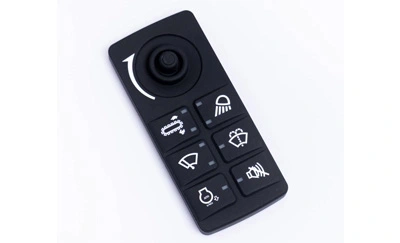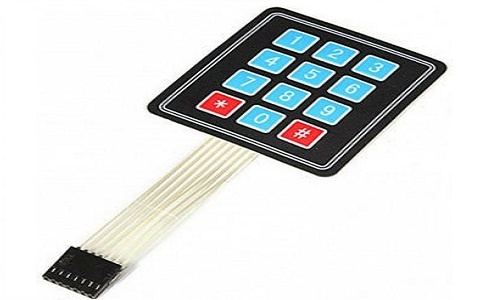Everything About Membrane Switch Over: A Comprehensive Overview for Beginners
Membrane switches are vital components in modern-day electronics, using an one-of-a-kind interface for customer interaction - membrane switch. Their split construction, including overlays and conductive traces, gives performance and durability. Unlike standard mechanical buttons, membrane switches provide a smooth design and customizable choices. Understanding their key features and benefits can transform product style. The complexities of their application and layout factors to consider require more exploration.
What Is a Membrane Change?
A membrane layer button is a type of electrical button that includes a flexible membrane layered over a published circuit board. This style enables for a compact and sleek interface, frequently made use of in various electronic tools. Membrane buttons are frequently discovered in customer appliances, medical devices, and commercial equipment due to their durability and resistance to environmental factors.The building commonly includes multiple layers, such as visuals overlays and glue support, which give tactile comments and secure the wiring underneath. The operation of a membrane layer button is started when pressure is used to the surface, completing an electrical circuit.These switches are valued for their versatility, making it possible for custom designs and published graphics that deal with certain customer interfaces. Their inconspicuous nature lowers room demands, making them optimal for applications where typical buttons may not fit. On the whole, membrane switches supply a useful and visual option for contemporary electronic tools.
Secret Elements of Membrane Layer Changes
Membrane changes make up a number of key parts that add to their functionality and performance. The leading layer, called the overlay, offers the interface and is often published with graphics or icons. Beneath the overlay lies a spacer layer, which separates the conductive components and stops inadvertent activation. The following vital element is the visuals layer, which enhances looks and guarantees the durability of the design.Conductive traces, commonly made from products like silver or carbon, are published on the circuit layer. When pressure is used to the overlay, these traces enter into call, completing the circuit. In addition, a backing layer offers architectural assistance and can be made from materials such as polyester or polycarbonate. With each other, these elements create a reliable, user-friendly interface suitable for numerous applications, from house home appliances to commercial tools. Comprehending these components is vital for anyone thinking about membrane switch modern technology.
How Membrane Changes Job
Understanding exactly how membrane layer changes function is necessary for valuing their widespread use in various tools. A membrane switch runs via a collection of layers, including a graphic overlay, spacer, and a circuit layer. When pressure is used to the overlay, it presses the spacer layer, allowing the circuit layer to make get in touch with and finish an electric circuit. This activity sends a signal to the device, motivating a reaction, such as switching on a light or turning on a function.Membrane switches over can be designed with different functions, consisting of tactile comments, backlighting, and custom graphics, enhancing individual interaction. Their building and construction permits a closed layout, shielding the internal components from dirt, moisture, and contaminants. This longevity makes them appropriate for varied applications, from consumer electronics to commercial devices. On the whole, the simplicity and performance of membrane layer switches add to their popularity in modern-day technology.
Advantages of Membrane Switches Mechanical Switches
While mechanical switches have actually long been a staple in many devices, membrane switches over deal unique advantages that make them progressively appealing. One considerable benefit is their slim account, enabling even more small designs and greater adaptability in item growth. In addition, membrane layer changes attribute a consistent surface area, which enhances visual allure and simplifies cleansing, making them appropriate for environments where health is critical.Another benefit is their resistance to dirt and wetness. Unlike mechanical switches, which can be endangered by ecological elements, membrane buttons supply a closed interface that shields versus pollutants - membrane switch. Furthermore, membrane layer switches usually have a longer life-span because of fewer moving parts, causing improved sturdiness and reliability.Cost-effectiveness is also a notable advantage, as membrane buttons can be produced wholesale with reduced production expenses. These elements incorporate to position membrane buttons as a functional option to standard mechanical options in numerous applications
Usual Applications of Membrane Layer Switches
Membrane buttons are widely utilized in different industries, specifically in consumer electronics and have a peek at this site commercial control board. In customer devices, they offer a smooth, straightforward interface, while in commercial setups, they enhance toughness and functionality. Comprehending these applications highlights the flexibility and usefulness of membrane layer buttons in contemporary innovation.
Customer Electronic Devices Devices
As consumer electronic devices remain to evolve, membrane buttons have actually become a prominent selection for a selection of tools due to their convenience and streamlined layout. These buttons are commonly located in mobile phones, tablets, and push-button controls, where area is restricted and looks issue. Their reduced account and adjustable styles enable manufacturers to create user-friendly interfaces that boost the total customer experience. In addition, membrane layer switches are commonly used in devices such as microwaves and coffee manufacturers, giving user-friendly control choices while standing up to wetness and dirt. The resilience and reliability of membrane layer changes make them appropriate for everyday customer products, making certain long life and consistent efficiency. Overall, their integration in customer electronic devices mirrors a mix of functionality and contemporary style.
Industrial Control Panels
The applications of membrane changes expand past consumer electronic devices, locating considerable use in industrial control board. These switches are favored for their toughness and resistance to rough settings, making them excellent for producing and process control settings. They supply a trustworthy interface for operators to regulate machinery, display procedures, and change setups. Membrane layer buttons can be customized to match specific operational demands, including attributes like backlighting and responsive comments, boosting user experience. Their low-profile design enables integration into various tools, while their capacity to hold up against spills, dust, and extreme temperatures warranties longevity. In general, membrane layer switches add to efficient and risk-free operation in commercial applications, showing their flexibility and effectiveness popular environments.
Considerations for Designing Membrane Layer Switches Over
When developing membrane layer buttons, picking the right products is important to ensure longevity and capability. In addition, recognizing layer configuration techniques can significantly impact the button's efficiency and customer experience. These factors to consider play a vital role in creating trusted and reliable membrane layer switch styles.
Material Selection Significance
Material choice plays an essential role in the layout and capability of membrane switches. The chosen products straight impact the button's longevity, responsive feedback, and general aesthetic. Key factors to consider include the substrate, which have to give architectural honesty while enabling versatility, and the graphic overlay, which needs to be immune to wear and environmental variables. Conductive products ought to assure reliable electric performance, while adhesives must supply strong bonding without jeopardizing the switch's procedure. Furthermore, compatibility with manufacturing processes and end-user settings is crucial; materials have to stand up to varying temperature levels, moisture levels, and chemical exposure. Eventually, suitable material option not just enhances the membrane layer button's efficiency however likewise contributes to its long life and user satisfaction, making it a crucial facet of the design process.

Layer Arrangement Strategies

Regularly Asked Inquiries
The Length Of Time Do Membrane Layer Switches Normally Last?
Membrane layer switches normally have a lifespan of 1 to 5 million cycles, depending upon use and ecological conditions. Variables such as design high quality and operating regularity significantly influence their durability and general efficiency longevity.

Can Membrane Layer Changes Be Customized for Specific Layouts?
Membrane buttons can without a doubt be personalized to fit specific layouts, enabling varied shapes, colors, and capabilities. This adaptability enables producers to customize these buttons to meet one-of-a-kind visual and functional demands effectively.
What Products Are Used in Membrane Layer Change Building And Construction?
Membrane layer switches are normally created making use of materials such as polyester, polycarbonate, and sticky layers. These materials offer versatility, longevity, and resistance to environmental aspects, making sure the switches function successfully in numerous applications and problems.
Are Membrane Switches Over Water Resistant or Immune to Dampness?
Membrane buttons can be designed to be moisture-resistant, utilizing specialized products and layers. Nonetheless, their waterproof capabilities depend on building high quality Home Page and certain applications, making it important to examine requirements for suitable efficiency in different environments.
Exactly How Are Membrane Layer Switches Repaired if Harmed?
Fixing broken membrane switches typically involves changing the influenced layer or circuit. Professionals might likewise apply conductive adhesive or use specialized fixing packages, making sure capability is restored without total replacement of the whole button assembly. Unlike traditional mechanical article source switches, membrane layer switches offer a streamlined style and customizable alternatives. A membrane layer switch is a kind of electrical button that is composed of a versatile membrane layered over a published circuit board. The operation of a membrane layer switch is initiated when pressure is used to the surface, finishing an electrical circuit.These buttons are valued for their adaptability, allowing custom layouts and printed graphics that provide to particular customer interfaces. While mechanical switches have long been a staple in lots of tools, membrane layer changes offer distinctive advantages that make them significantly appealing. Membrane switches usually have a longer lifespan due to less relocating parts, resulting in boosted durability and reliability.Cost-effectiveness is additionally a significant advantage, as membrane buttons can be produced in mass with reduced production costs.
Comments on “Membrane switch in consumer electronics: design considerations”